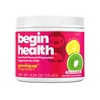How Much Magnesium Should Kids Have?
share this article

Why Magnesium Matters for Growing Kids
Magnesium is an essential mineral that supports hundreds of biological processes in the body, from nerve signaling and muscle function to energy production and digestion. It also plays a critical role in gut motility, bone development, and sleep regulation, making it especially important during childhood and adolescence.
Yet studies show that many kids fall short of the recommended intake, especially picky eaters and those following processed, low-fiber diets. Data from studies show that nearly 1 in 3 children in the U.S. may not be getting enough magnesium on a regular basis [2].
So how much magnesium does your kid actually need?
Recommended Daily Magnesium Intake for Kids
According to the National Institutes of Health (NIH), here are the daily recommended dietary allowances (RDAs) for magnesium based on age [1]:
|
Age |
Magnesium RDA |
|
1–3 years |
80 mg/day |
|
4–8 years |
130 mg/day |
|
9–13 years |
240 mg/day |
|
14–18 years (girls) |
360 mg/day |
|
14–18 years (boys) |
410 mg/day |
These values represent the total daily intake from food and supplements combined.
Signs Your Kid May Not Be Getting Enough Magnesium
While overt magnesium deficiency is rare, low intake over time can lead to subtle symptoms, such as:
-
Constipation or hard stools
-
Muscle cramps or restless legs
-
Irritability or anxiety
-
Trouble sleeping
-
Low energy or fatigue
Kids with digestive issues (like constipation or IBS), low-fiber diets, or high intakes of processed foods may be especially at risk.
Top Food Sources of Magnesium for Kids
Many magnesium-rich foods are kid-friendly if prepared in fun, approachable ways:
-
Leafy greens (spinach, kale) – add to smoothies
-
Beans and lentils – try in soups or tacos
-
Nuts and seeds (almonds, sunflower seeds, chia) – blend into snacks or bars
-
Whole grains (brown rice, oats, whole wheat pasta)
-
Bananas, avocados, and dark chocolate
-
Low-fat dairy and fortified plant-based milks
Still, many kids don’t hit their targets through food alone, especially if they’re picky eaters or have allergies. In these cases, a magnesium supplement may be helpful.
What About Magnesium Supplements?
Magnesium supplements for kids come in several forms, but not all are created equal. Here’s what to consider:
-
Elemental magnesium matters: The amount listed on the label refers to total magnesium compound, but only part of it is actual magnesium your kid’s body can absorb.
-
Magnesium citrate and magnesium glycinate are often preferred for kids because they are gentle on the stomach and well absorbed.
-
Avoid magnesium oxide, which has poor absorption and can cause cramping or diarrhea.
The Tolerable Upper Intake Level (UL) for magnesium from supplements (not food) is:
|
Age |
Upper Limit from Supplements |
|
1–3 years |
65 mg/day |
|
4–8 years |
110 mg/day |
|
9–18 years |
350 mg/day |
Staying below these levels helps avoid side effects like loose stools or abdominal cramping.
Summary
Magnesium is an essential mineral for kids’ gut health, energy, and development, but many kids don’t get enough from modern diets and food alone. Depending on age, kids need between 80–410 mg of magnesium daily, and supplements can help fill gaps when used appropriately.
If you’re considering a magnesium supplement for your little one, look for well-tolerated forms like magnesium glycinate or citrate and stay within the age-appropriate upper limits for safety.
















